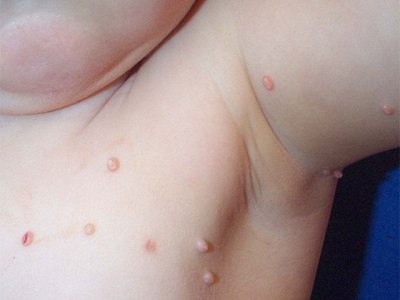Umbilical warts or in Latin Molluscum Contagiosum is a viral skin disease that mainly affects children of preschool age and manifests itself in skin lesions usually 1-3 mm in diameter that can appear as single or multiple lesions. Although the virus is a close relative of the monkey pox virus - the warts do not endanger health and are only an aesthetic problem. At the same time - until the development of a vaccine and spontaneous recovery without treatment, the disease can continue between six months and two years, the lesions may proliferate greatly, become secondarily infected with painful bacterial infections and is often accompanied by unpleasant tingling and eczema around the lesions. Often there is involvement of delicate skin areas such as the genitals and groin and the face. The tingling and eczema cause the patient to scratch the warts and spread the infection with his fingernails from place to place on the skin.
The disease is highly contagious and very common (it is generally accepted that close to 1.5% of the world's population suffers from it at one point or another) and is easily transmitted between children mainly, usually by skin-to-skin contact and also by contact with objects such as towels, items of clothing, toys and in water. In rare cases, the disease also appears in teenagers and even in adults, and then may indicate an immune deficiency or manifest as a sort of sexually transmitted disease.
The therapeutic approach varies between patiently waiting for recovery on the one hand and on the other hand, early intervention to prevent prolonged suffering, infection of additional family members, secondary infection, and more.
It is recommended to have a dermatologist examination after the symptoms appear, to stop the progression of the disease and prevent complications.
Treatment options include liquid nitrogen treatment (cold burn), mechanical peeling of the warts using a device (curett) and treatment using various chemical substances that cause burns, pain and often scars. In extreme cases with a large amount of warts and in cases where the children fail to cooperate during the treatment - the treatment can be performed in a hospital under sedation (induced sleep/light anesthesia).
In recent years, an effective treatment has been discovered using a chemical called cantharidin that is extracted from a special beetle and upon contact causes a pinpoint blister that separates the wart from the skin. This is a treatment performed by the doctor in the clinic and after 10-14 days the treated lesions dry up and disappear.
Dr. Gilead has extensive experience in the treatment of umbilical warts and, among other things, treatments are performed using cantharidin and/or liquid nitrogen (the treatments are not included in the consultation price). In the clinic visit, an assessment of the warts condition is carried out and general therapeutic measures are outlined to improve the condition of the skin and to encourage recovery.
In order to receive treatment, one must come for an examination and consultation visit for diagnosis and confirmation of the type of lesions and to decide on the appropriate treatment according to the type and amount of lesions, their location, the age of the patient and his preferences.
Dr. Gilead will explain the nature of the findings, their significance, the need and urgency of the treatment and the appropriate method of treatment. After the patient and the doctor agree on the appropriate treatment, it will be decided whether it can be performed as part of the visit or whether it is necessary to coordinate a special date for the treatment. It should be emphasized that the various treatments are charged separately and not included in the consultation visit fee.

